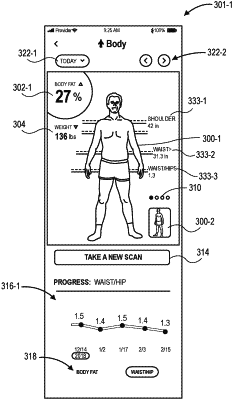| CPC G06T 7/60 (2013.01) [G01B 11/24 (2013.01); G06T 7/11 (2017.01); G06T 7/70 (2017.01); G06T 17/20 (2013.01); G06V 40/103 (2022.01); G06T 2207/20081 (2013.01); G06T 2207/20084 (2013.01); G06T 2207/30196 (2013.01)] | 22 Claims |

|
1. A computer-implemented method, comprising:
receiving a first two-dimensional (“2D”) body image of a human body from a 2D camera;
processing the first 2D body image to segment a first plurality of pixels of the first 2D body image that represent the human body from a second plurality of pixels of the first 2D body image that do not represent the human body to produce a first silhouette of the human body;
processing the first silhouette using a convolutional neural network to produce a plurality of body dimensions corresponding to the human body;
generating, based at least in part on the first silhouette or at least some of the plurality of body dimensions, a personalized three-dimensional (“3D”) body model of the human body;
comparing the personalized 3D body model with at least one of the human body represented in the 2D body image or the first silhouette to determine a difference between the personalized 3D body model and at least one of the human body represented in the 2D body image or the first silhouette;
refining, based at least in part on the difference, the first silhouette to produce a refined silhouette; and
processing the refined silhouette using the convolutional neural network to produce a refined plurality of body dimensions corresponding to the human body.
|
|
18. A method, comprising:
processing a first two-dimensional (“2D”) body image that includes a representation of a body from a first view to produce a first silhouette of the body;
determining, based at least in part on the first silhouette, a plurality of body dimensions corresponding to the body;
generating, based at least in part on the first silhouette, a three-dimensional (“3D”) model of the body;
comparing the 3D body model with at least one of the body represented in the 2D body image or the first silhouette to determine a difference between the 3D body model and at least one of the body represented in the 2D body image or the first silhouette;
refining, based at least in part on the difference, the first silhouette to produce a refined silhouette;
processing the refined silhouette to produce a refined plurality of body dimensions corresponding to the human body;
generating, based at least in part on the refined silhouette, a refined 3D model of the body; and
sending, for presentation, the refined 3D model of the body and at least one dimension of the refined plurality of body dimensions.
|